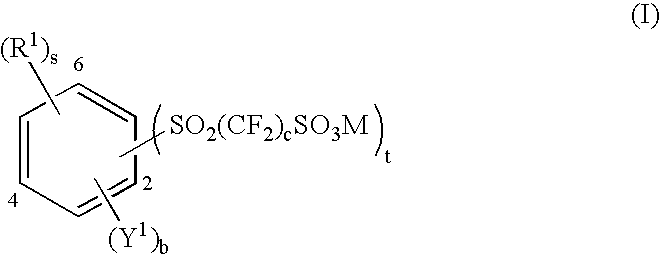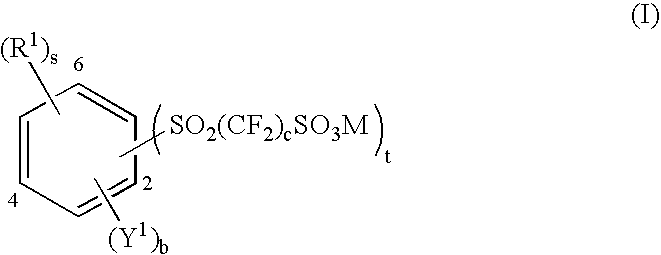Aromatic polyethers
a technology of aromatic polyethers and polyethers, applied in the field of aromatic polyethers polymers, can solve the problems of insufficient conductivity under the necessary temperature and humidity requirements, poor chemical, mechanical and thermal properties, and high cost of fuel cell membranes
- Summary
- Abstract
- Description
- Claims
- Application Information
AI Technical Summary
Problems solved by technology
Method used
Image
Examples
example 1
Provides a Process for the Preparation of Sodium 2-(2,6-dichlorothiobenzene)tetrafluoroethanesulfinate, compound (2)
[0058]2,6-(2-Bromotetrafluoroethyl)dichlorothiobenzene compound (1) (150.0 g, 419 mmol) was dissolved in N,N-dimethyl formamide (DMF, 125 ml) and added to a 1 liter (L) round-bottomed flask containing sodium dithionite (160 g, 921 mmol), sodium bicarbonate (NaHCO3, 77.0 g, 917 mmol), and deionized water (225 ml). The reaction mixture became exothermic and the temperature of the reaction mixture increased to 40° C. Sulfur dioxide gas was released from the reaction mixture. The reaction mixture was then heated to 65° C. and stirred at 65° C. for 1 hour. The reaction mixture was then heated to 75° C. and stirred at 75° C. for 2 hours. The reaction mixture was then cooled to 25° C. and ethyl acetate (500 ml) was added to the mixture and stirred. The mixture was then filtered over Celite and a C-frit. The phases were separated and the aqueous phase was further extracted wi...
example 2
Provides a Process for the Preparation of 2-(2,6-dichlorothiobenzene)tetrafluoroethanesulfonyl chloride, compound (3)
[0059]Sodium 2-(2,6-dichlorothiobenzene)tetrafluoroethanesulfinate, compound (2) (37.2 g, 102 mmol) was dissolved in deionized water (250 ml). Bleach (400 ml, 6.15 percent sodium hypochlorite solution in water) was added at 25° C., resulting in a cloudy suspension. The mixture was vigorously stirred for 2 minutes and methylene dichloride (200 ml) was added. The phases were separated and the aqueous phase was further extracted with CH2Cl2 (3×100 ml). The combined organic phases were washed with brine (2×150 ml), dried over MgSO4, filtered, and concentrated under reduced pressure to provide a colorless liquid which was purified by vacuum distillation (112° C. at 75 millitorr (mTorr)) to provide 31.5 g of 2-(2,6-dichlorothiobenzene)tetrafluoroethanesulfonyl chloride, compound (3). 1H NMR (CDCl3, 400 MHz): δ 7.53 (2H, d, J=8.0 Hz, ArH); and 7.42 (1H, t, J=8.0 Hz, ArH). 1...
example 3
Provides a Process for the Preparation of 2-(2,6-dichlorothiobenzene)tetrafluoroethanesulfonyl fluoride, compound (4)
[0060]2-(2,6-dichlorothiobenzene)tetrafluoroethanesulfonyl chloride, compound (3) (31.0 g, 82.1 mmol) was dissolved in anhydrous acetonitrile (CH3CN, 50 ml) and added to an oven-dried round-bottom flask containing anhydrous potassium fluoride (KF, 25.5 g, 439 mmol). The reaction mixture was heated to 70° C. over a period of 10 minutes and stirred at 70° C. for 16 hours. The resultant mixture was filtered and concentrated under reduced pressure to provide a colorless liquid which was purified by vacuum distillation (60° C. to 61° C. at 20 mTorr), to provide 29.6 g of 2-(2,6-dichlorothiobenzene)tetrafluoroethanesulfonyl fluoride, compound (4). 1H NMR (CDCl3, 400 MHz): δ 7.53 (2H, d, J=8.0 Hz, ArH) and 7.42 (1H, t, J=8.0 Hz, ArH). 19F NMR (CDCl3, 564.4 MHz): 46.6 (1F, m, SO2F), −84.9 (2F, m, CF2) and −106.6 (2F, quartet, JFF=5 Hz, CF2).
PUM
| Property | Measurement | Unit |
|---|---|---|
| proton conductivity | aaaaa | aaaaa |
| proton conductivity | aaaaa | aaaaa |
| proton conductivity | aaaaa | aaaaa |
Abstract
Description
Claims
Application Information
 Login to View More
Login to View More - R&D
- Intellectual Property
- Life Sciences
- Materials
- Tech Scout
- Unparalleled Data Quality
- Higher Quality Content
- 60% Fewer Hallucinations
Browse by: Latest US Patents, China's latest patents, Technical Efficacy Thesaurus, Application Domain, Technology Topic, Popular Technical Reports.
© 2025 PatSnap. All rights reserved.Legal|Privacy policy|Modern Slavery Act Transparency Statement|Sitemap|About US| Contact US: help@patsnap.com



